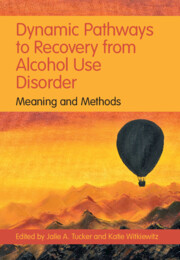Book contents
- Dynamic Pathways to Recovery from Alcohol Use Disorder
- Dynamic Pathways to Recovery from Alcohol Use Disorder
- Copyright page
- Dedication
- Contents
- Figures
- Tables
- Contributors
- Foreword
- Preface
- Acknowledgments
- Introduction
- Part I Micro Level
- Part II Meso Level
- Part III Macro Level
- 16 Recovery Communities
- 17 Disparities in Alcohol Treatment Access in Rural Areas
- 18 Recovery, Communities, and the Organized Recovery Movement
- 19 Alcohol Control Policy and Regulations to Promote Recovery from Alcohol Use Disorder
- 20 Causal Inference Approaches to Studying Recovery from Alcohol Use Disorder
- 21 Building on Collaborative Research to Co-Design SURE Recovery, a Mobile Application for People with Experience of Alcohol and Other Drug Problems
- 22 Economic Methods Used to Evaluate Recovery Programs for Alcohol Use Disorder
- Conclusions and Future Directions
- Index
- References
18 - Recovery, Communities, and the Organized Recovery Movement
from Part III - Macro Level
Published online by Cambridge University Press: 23 December 2021
- Dynamic Pathways to Recovery from Alcohol Use Disorder
- Dynamic Pathways to Recovery from Alcohol Use Disorder
- Copyright page
- Dedication
- Contents
- Figures
- Tables
- Contributors
- Foreword
- Preface
- Acknowledgments
- Introduction
- Part I Micro Level
- Part II Meso Level
- Part III Macro Level
- 16 Recovery Communities
- 17 Disparities in Alcohol Treatment Access in Rural Areas
- 18 Recovery, Communities, and the Organized Recovery Movement
- 19 Alcohol Control Policy and Regulations to Promote Recovery from Alcohol Use Disorder
- 20 Causal Inference Approaches to Studying Recovery from Alcohol Use Disorder
- 21 Building on Collaborative Research to Co-Design SURE Recovery, a Mobile Application for People with Experience of Alcohol and Other Drug Problems
- 22 Economic Methods Used to Evaluate Recovery Programs for Alcohol Use Disorder
- Conclusions and Future Directions
- Index
- References
Summary
The organized recovery community includes individuals, family members and loved ones; professionals; and community stakeholders affected by substance use disorders and serves an important role in the creation, adoption, and maintenance of the infrastructure and policies that help support individuals living in or seeking to initiate recovery. As a relatively new socially organized community, the organized recovery community has bolstered efforts to create supportive services, such as recovery community organizations and peer recovery support services; implement recovery-informed systems design, such as recovery-oriented systems of care; enact recovery-centric policies, such as the Comprehensive Addiction and Recovery Act of 2016; and assist in the co-creation of a new branch of scientific discovery, recovery science. This chapter explores the origins, makeup, and real-world impact of the organized recovery movement in the United States.
Keywords
- Type
- Chapter
- Information
- Dynamic Pathways to Recovery from Alcohol Use DisorderMeaning and Methods, pp. 335 - 345Publisher: Cambridge University PressPrint publication year: 2022



